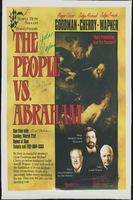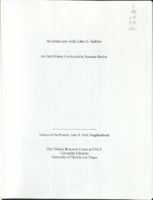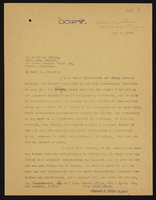Search the Special Collections and Archives Portal
Search Results

Poster for "The People Vs. Abraham," Las Vegas (Nev.), circa 2004
Date
Archival Collection
Description
The front of a poster for the mock trial "The People Vs. Abraham" put on by Temple Beth Sholom in Las Vegas, Nevada. The advertising text reads: "Temple Beth Sholom proudly presents "The People Vs. Abraham." One time only. Sunday, March 21st. Opens at 9am. Tickets call 702-804-1333. Be there as masterful attorneys Oscar Goodman and Michael Cherry go before hard nosed Judge Joseph Wapner. A trial with roots at the foundation of Jewish heritage. Hear extraordinary details of passionate father nearly sacrificing his son. Then you, the jury, cast the deciding vote." The signatures of Michael Cherry, Oscar Goodman, and Joseph Wapner are included on the poster as well.
Mixed Content

Transcript of an interview with Clinton Wright by Claytee D. White, October 13, 2005
Date
Archival Collection
Description
Clinton Wright worked as a photographer for the Las Vegas Voice for fifteen years. In his interview, he discusses living and working in Las Vegas, and raising his family.
Text
Sandy Daly oral history interview
Identifier
Abstract
Oral history interview with Sandy Daly conducted by Bud Stephen on June 20, 1972 for the Ralph Roske Oral History Project. Daly moved to Las Vegas, Nevada in 1947 and she describes her educational experiences and how the gaming industry related to her upbringing. Stephen also asks questions relating to politics, religion, social club membership, theater, recreational activities for children and adults, atomic testing, tourism, local sports, television, prostitution, social class, and the development of the Strip. Interview includes audio recording (analog, digital) and transcript (digital).
Archival Collection
Jeanettee L. Del Rosario oral history interview
Identifier
Abstract
Oral history interview with Jeanettee L. Del Rosario conducted by Alessandra Del Rosario on December 6, 2021 for Reflections: The Las Vegas Asian American and Pacific Islander Oral History Project.
Jeanettee Del Rosario talks about her family life with nine siblings and her upbringing in Urdaneta City, Pangasinan province, Philippines. She shares her educational background in hotel and restaurant management and, after immigrating to Las Vegas, Nevada in 2006, the different hotel positions she has held in the city. Jeanettee Del Rosario discusses the process of immigration, language barriers, and missing her family in the Philippines. She also talks about Filipino traditions of respect, barangay fiestas, cultural foods, and religion.
Archival Collection
William Brymer oral history interview
Identifier
Abstract
Oral history interview with William Brymer conducted by Rob Mullaney on March 09, 1979 for the Ralph Roske Oral History Project on Early Las Vegas. Brymer explains how he moved to Las Vegas, Nevada for the gaming attractions and eventually married and had two children. Brymer talks about working as a craps dealer at the Frontier Club in Downtown Las Vegas, the Last Frontier on the Las Vegas Strip, and later a pit boss at the Sahara. Brymer also discusses a visit by Lyndon B. Johnson, the early atomic testing, the importance of religion in his life, changes in climate, the development of the Strip, the existence and decline of agriculture, and some of the entertainers who performed on the Strip.
Archival Collection

Transcript of interview with Miriam "Mimi" Katz by Barbara Tabach, December 10, 2014
Date
Archival Collection
Description
In this interview, Mimi Katz discusses growing up in the Boston area and her schooling, and moving to Washington, D.C. working as a physiotherapist. She returned to Boston and met her husband, and she talks about moving to Las Vegas and adjusting to life here. They became involved at Temple Beth Sholom, and Mimi worked as a conventions coordinator at the Sands and the Sahara. She discusses moving around in Las Vegas from an apartment to a house in the John S. Park neighborhood, working for the Jewish Federation, and helping to develop the Holocaust education program with Edythe Katz, conducting oral history interviews with survivors. She continued working at the Convention Center in the 1980s, and is involved in the Lou Ruvo Center.
Everyone knows her as Mimi. She was born Miriam Green to immigrant parents in Boston, Massachusetts, in 1926. As a youngster she danced, excelled at school and enjoyed an abundance of sports. To pay for her higher education at Massachusetts School of Physiotherapy she worked at Raytheon Manufacturing. In 1957 she married George Katz who swept her away to their honeymoon in Las Vegas. It's a story that she loves to recall-they never left. She sent for her things and energetically settled in to her new hometown and marriage. Mimi found employment with the Clark County School District, began having children (three daughters), and making fast new friends. Many of these friends were from the founding days of Temple Beth Sholom, which roots her to the history of the local Jewish community. In addition, for a decade she worked in community relations for the Jewish Federation. She valued community activism and volunteered over the years for many organizations; such as Easter Seals, Jewish War Veterans, Parent Teachers Association and the Lou Ruvo Center for Brain Health, and many more organizations over the subsequent decades.
Text

Transcript of interview with John G. Gubler by Suzanne Becker, December 29, 2008
Date
Archival Collection
Description
Text

Video, Yom Hashoah Holocaust Memorial Observance, Governor's Mansion, April 4, 2013
Date
Archival Collection
Description
Video recording of Yom Hashoah event held at the Governor's Mansion in Carson City, Nev.
Moving Image


